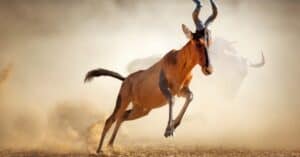Like most people, you might not be sure what a kudu is. This African antelope received its name from the Khoikhoi, a people indigenous to southwestern Africa. There are two species of kudus, the lesser kudu and the greater kudu. But what’s the difference between them? Read on to compare the lesser kudu vs greater kudu!
Comparing a Lesser Kudu vs Greater Kudu

Kudus roam the lowlands and up into the hills and mountainous regions.
©yykkaa/Shutterstock.com
| Lesser Kudu | Greater Kudu | |
|---|---|---|
| Scientific Name | Tragelaphus imberbis | Tragelaphus strepsiceros |
| Habitat | Northeastern Africa Arid and semiarid scrublands, savannas, and woodlands Lowlands, hills, and mountains | Eastern and southern Africa Scrublands, savannas, and woodlands Lowlands, hills, and mountains |
| Size | Males: 37-41 inches tall, 200-230 pounds Females: 35-39 inches tall, 130-160 pounds | Males: 51-59 inches tall, 420-600 pounds Females: Up to 47 inches tall, 260-460 pounds |
| Appearance | Spiral horns (males), spinal crest, facial stripes or patches, 2 white chest patches, greyish-brown coat (males) or reddish-brown coat (females), 11-15 white stripes | Spiral horns (males), spinal crest, cheek patches, nose chevron, throat beard, greyish-brown coat (males) or reddish-brown coat (females), 6-10 white stripes |
| Reproduction | Breeds any time of year, gives birth to 1 calf at a time | Breeds near the end of the rainy season, gives birth to 1 calf at a time |
| Behavior | Males: Solitary, unaggressive Females: Gregarious, unaggressive | Males: Solitary, unaggressive Females: Gregarious, unaggressive |
The Key Differences Between a Lesser Kudu and a Greater Kudu
The lesser kudu (Tragelaphus imberbis) and the greater kudu (Tragelaphus strepsiceros) are two species known collectively as the kudu. The key differences between a lesser kudu and a greater kudu are habitat, size, appearance, reproduction, and behavior.
Lesser Kudu vs Greater Kudu: Habitat

The greater kudu inhabits eastern and southern Africa, while the lesser kudu inhabits northeastern Africa.
The lesser kudu lives in areas of northeastern Africa, including the countries of Ethiopia, Kenya, Somalia, Uganda, Tanzania, and South Sudan. The greater kudu inhabits regions of eastern and southern Africa. It makes its home in many countries, including Ethiopia, Tanzania, and Kenya in the east and Zambia, Angola, Namibia, Botswana, Zimbabwe, and South Africa in the south.
Both the lesser and greater kudu prefer to inhabit scrublands, savannas, and woodlands, though the lesser kudu prefers arid or semiarid regions. Kudus roam the lowlands and up into the hills and mountainous regions. Both species avoid open areas without cover for fear of being ambushed by predators.
Lesser Kudu vs Greater Kudu: Size
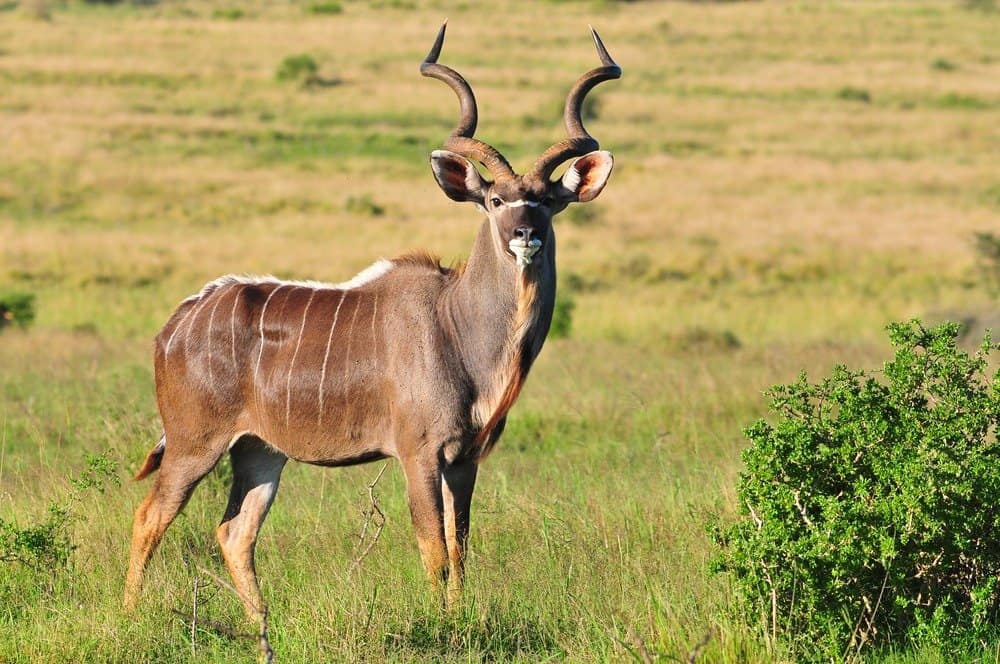
The greater kudu stands as tall as 5 feet at the shoulder and weighs as much as 600 pounds.
©Michael Potter11/Shutterstock.com
As their name suggests, lesser kudus are the smaller of the two species. Females reach 35-39 inches at the shoulder (approximately 2.9 to 3.25 feet) and weigh 130-160 pounds. Males are somewhat larger, reaching between 37-41 inches at the shoulder (approximately 3 to 3.5 feet) and weighing 200-230 pounds.
Greater kudus are significantly larger than their lesser cousins. Females stand up to 47 inches (approximately 4.9 feet) at the shoulder and weigh between 260-460 pounds. This makes them much heavier on average than the male lesser kudu. Males stand 51-59 inches at the shoulder (approximately 4.25 to 5 feet) and weigh a whopping 420-600 pounds. The largest buck on record weighed 690 pounds. Greater kudus are among the largest antelopes in the world, though first place goes to the giant eland.
Lesser Kudu vs Greater Kudu: Appearance

Lesser kudus have 11-15 white stripes on their bodies, while greater kudus only have 6-10.
©Millie Bond – Copyright A-Z Animals
Aside from the difference in size, there are other ways to distinguish between the lesser and greater kudus. Males of both species have horns, though larger in the greater kudu, growing up to 4.5 feet long. By contrast, the lesser kudu’s horns only grow up to 2.3 feet in length.
Both species have white facial markings. In the lesser kudu, they take the form of stripes and spots. In the greater kudu, they appear as cheek patches. Both also have nose chevrons and spinal crests. The lesser kudu, however, has 2 white chest patches while the greater kudu sports a throat beard. Males of both species have greyish-brown coats, while females’ coats are reddish-brown. Some individuals may have bluish-grey coats. Lesser kudus have 11-15 white stripes on their bodies; their greater cousins have only 6-10.
Lesser Kudu vs Greater Kudu: Reproduction
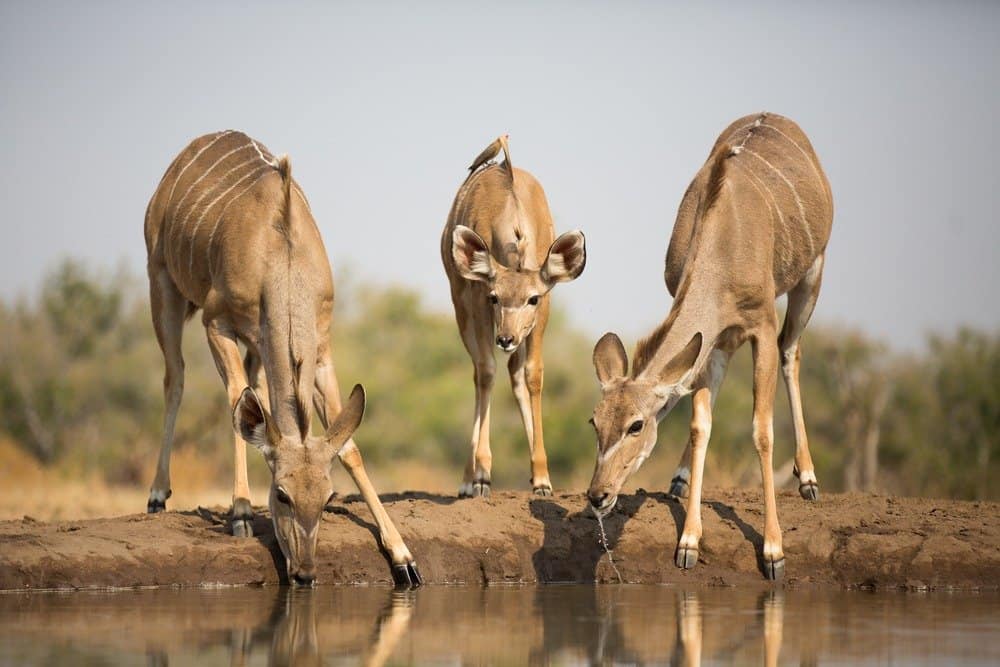
Female kudus give birth to 1 calf after a gestation period of 7-9 months.
©Villiers Steyn/Shutterstock.com
Lesser kudus breed throughout the year, unlike greater kudus, which calf during the rainy season (February-June) and breed near the end of the rains. Lesser kudus of both sexes reach sexual maturity by 18 months, though males don’t mate until they reach 4-5 years of age. Female greater kudus are sexually mature by 15-21 months, with male greater kudus maturing by 21-24 months.
Female kudus leave their herd to give birth in a safe and solitary place. Cows give birth to one calf at a time after a gestation period of 7-9 months. After the calf is born, the mother will leave it lying by itself under cover for 4-5 weeks until it is strong enough to accompany her for short periods. By 3-4 months, the young kudu constantly remains with its mother. The female and her calf then return to the herd. The calf is usually mature enough to be independent of its mother at 6 months of age.
Lesser Kudu vs Greater Kudu: Behavior
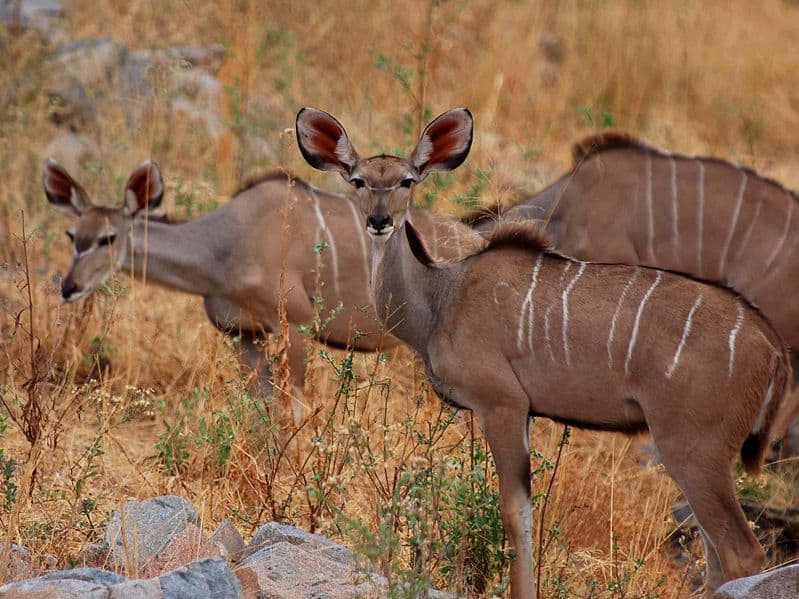
Female kudus are gregarious, remaining in herds comprised of other females and young.
Both species of kudus are generally unaggressive. Conflicts between males don’t usually end in injury or death. Typically, each male will display his size by standing sideways in front of the other and trying to make himself look larger. This is called a lateral display. Males of both species are solitary for the most part, choosing to live their lives on their own. There are two exceptions to this. The first is during mating time, when males compete to attract females. The other is rarer and involves males forming small bachelor groups.
Female kudus are gregarious, spending their lives in herds of other females and young. Herds comprise up to 24 individuals, partly for socialization and partly for protection from predators. By 6 months, young kudus can roam independently of their mother, and young males may leave at this point to begin their solitary existence.
Lesser Kudu vs Greater Kudu: Diet and Predators

Due to the arid conditions in their regions, lesser kudus rely on moisture from plant sources and watering holes.
Lesser and greater kudus are herbivores, consuming nothing but plant matter. Due to the arid conditions in their preferred territories, lesser kudus have adapted to rely on water from their food sources for much of their hydration. Both species eat leaves, twigs, shrubs, herbs, grasses, and roots. Fruits and flowers are welcome additions to their diet if available.
Both species of kudus are at risk from many predators. Potential attackers include lions, leopards, hyenas, African wild dogs, and humans.
Lesser Kudu vs Greater Kudu: Lifespan
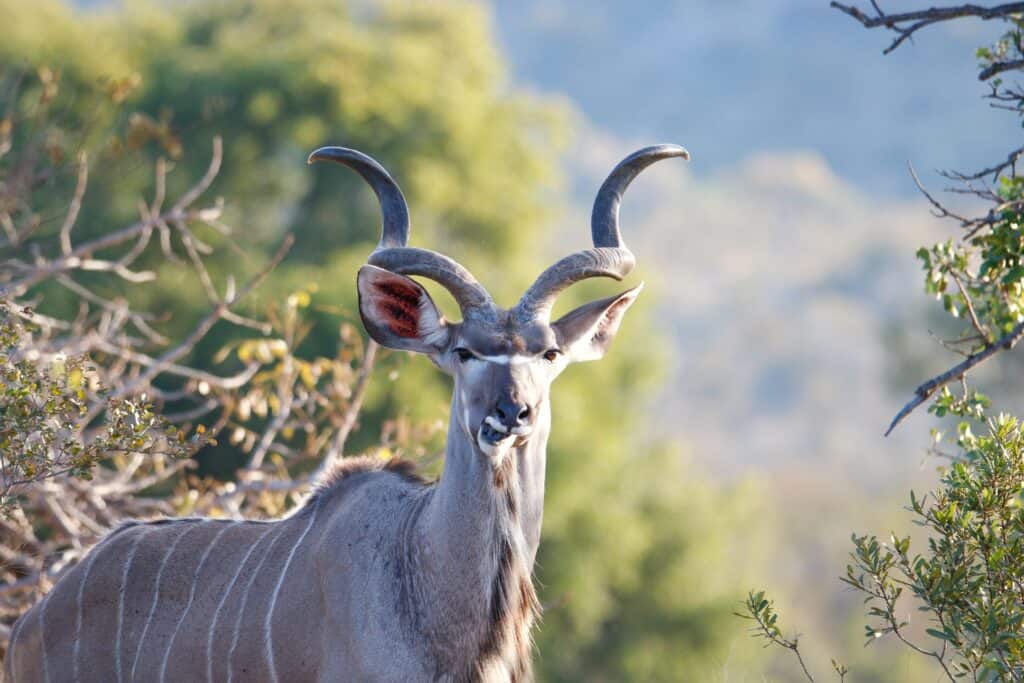
Though the IUCN lists greater kudus as a species of least concern, the lesser kudu’s numbers are diminishing.
©Michelle Niemand/Shutterstock.com
Lesser kudus usually live 10-15 years in the wild and up to 20 years in captivity. Greater kudus live somewhat shorter lives in the wild at 7-8 years but may live up to 23.5 years in captivity.
Though the IUCN lists greater kudus as a species of least concern, the lesser kudu’s numbers are diminishing, and this decrease has earned it the status of Near Threatened. The African Wildlife Foundation notes habitat loss and poaching as causes of the lesser kudu’s decrease. With care, both species of kudus can continue to flourish far into the future.
The photo featured at the top of this post is ©
Thank you for reading! Have some feedback for us? Contact the AZ Animals editorial team.



